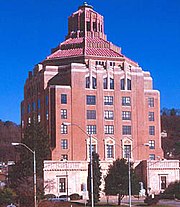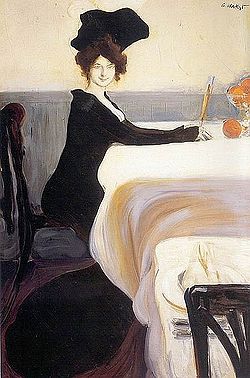Art Deco
From Wikipedia, the free encyclopedia.

Art Deco (French: Exposition Internationale des Arts Décoratifs et Industriels Modernes) was an early twentieth century movement in the decorative arts, that also grew in influence to affect architecture, fashion and the visual arts.
Contents |
Overview
Art Deco derived its name from the World's fair held in Paris in 1925, formally titled the Exposition Internationale des Arts Décoratifs et Industriels Modernes, which showcased French luxury goods and reassured the world that Paris remained the international center of style after World War I. Art Deco did not originate with the Exposition; it was a major style in Europe from the early 1920s, though it did not catch on in the U.S. until about 1928, when it quickly modulated into the Streamline Moderne during the 1930s, the decade with which Americanized Art Deco is most strongly associated today.
Paris remained the center of the high end of Art Deco design, epitomized in furniture by Jacques-Emile Ruhlmann, the best-known of Art Deco furniture designers and perhaps the last of the traditional Parisian ébénistes, and Jean-Jacques Rateau, the firm of Süe et Mare, the screens of Eileen Gray, wrought iron of Edgar Brandt, metalwork and lacquer of Jean Dunand, the glass of René Lalique and Maurice Marinot, clocks and jewelry by Cartier.
The term Art Deco was coined during the Exposition of 1925 but did not receive wider usage until it was re-evaluated in the 1960s. Its practitioners were not working as a coherent community. It is considered to be eclectic, being influenced by a variety of sources, to name a few:
- Early work from the Wiener Werkstätte; functional industrial design
- "Primitive" arts of Africa, Egypt, or Aztec Mexico
- Ancient Greek sculpture and pottery design of the less naturalistic "archaic period"
- Léon Bakst's sets and costumes for Diaghilev's Ballets Russes
- Fractionated, crystalline, facetted form of decorative Cubism and Futurism
- Fauve color palette
- Severe forms of Neoclassicism: Boullée, Schinkel
- Everything associated with Jazz, Jazz Age or "jazzy"
- Animal motifs and forms; tropical foliage; ziggurats; crystals; "sunbursts"; stylized fountain motifs
- Lithe athletic "modern" female forms; flappers' bobbed haircuts
- "Machine age" technology such as the radio and skyscraper.

Corresponding to these influences, the Art Deco is characterised by use of materials such as aluminium, stainless steel, lacquer, inlaid wood, sharkskin, and zebraskin. The bold use of zigzag and stepped forms, and sweeping curves (unlike the sinuous curves of the Art nouveau), chevron patterns, and the sunburst motif. Some of these motifs were ubiquitous- for example the sunburst motif was used in such varied contexts as a lady's shoe, a radiator grille, the auditorium of the Radio City Music Hall and the spire of the Chrysler Building. Art Deco was an opulent style and this opulence is attributed as a reaction to the forced austerity during the years of World War I. Art Deco was a popular style for interiors of cinema theatres and ocean liners such as the Ile de France and Normandie.
A parallel movement following close behind, the Streamline or Streamline Moderne, was influenced by manufacturing and streamlining techniques arising from science and mass production- shape of bullet, liners, etc., where aerodynamics are involved. Once the Chrysler Air-Flo design of 1933 (date) was successful, "streamlined" forms began to be used even for objects such as pencil sharpeners and refrigerators. In architecture, this style was characterised by rounded corners, used predominantly for buildings at road junctions.
Some historians see Art Deco as a type of or early form of Modernism.
Art Deco slowly lost patronage in the West after reaching mass production, where it began to be derided as gaudy and presenting a false image of luxury. Eventually the style was cut short by the austerities of World War II. In colonial countries such as India, it became a gateway for Modernism and continued to be used well into the 1960s. A resurgence of interest in Art Deco came with graphic design in the 1980s, where its association with film noir and 1930s glamour led to its use in ads for jewelry and fashion. This is still the image of Art Deco held in the minds of most Americans.
Noted Art Deco artists and designers

- Adolphe Mouron Cassandre
- Jean Dunand
- Jean Dupas
- Erté (Romain de Tirtoff) (1892-1990)
- Alexandra Exter
- Eileen Gray
- George Jensen
- René Lalique
- Jules Leleu
- Tamara de Lempicka
- Paul Manship
- Émile-Jacques Ruhlmann
- Sue et Mar
- Walter Dorwin Teague
- Carl Paul Jennewein
Noted Art Deco architects
- Ernest Cormier
- Raymond Hood
- Le Corbusier (Charles Edouard Jeanneret-Gris)
- William van Alen
- Wirt C. Rowland
- Joseph Sunlight
Noted Art Deco designs
- The Argyle Hotel in Los Angeles, California
- The Bullock's Wilshire Building in Los Angeles, California(now home to Southwestern University School of Law)
- Empire State Building
- Chrysler Building
- Dallas Fair Park Hall of State
- Golden Gate Bridge
- Fisher Building in Detroit
- Guardian Building in Detroit
- The Mapes Hotel in Reno, Nevada
- Peace Hotel in Shanghai
- Asmara, the capital city of Eritrea
- The ocean liners Ile de France, Normandie and RMS Queen Mary
- The Montreal Eaton 9th floor restaurant is a copy of the huge SS Ile de France first class dining room
- Napier, New Zealand - In 1931 the city of Napier was levelled by the Napier earthquake and ensuing fires. The city was rebuilt in the Art Deco style.
- The Hoover Building, Perivale, London
- The India Tyres of Inchinnan office block, Inchinnan, Renfrewshire, Scotland
- Anzac War Memorial, Sydney built 1929-34 designed C Bruce Dellit (1900-1942), Sculptor: Rayner Hoff.
- Radio City Music Hall
- Université de Montréal central building
- Supreme Court of Canada in Ottawa
- Marine Building in Vancouver
- The East and West Stands at Arsenal Stadium in London
- Eltham Palace extension, south-east London
- The Colleen Moore Dollhouse at the Chicago Museum of Science and Industry
- Boston Avenue Methodist Church in Tulsa, Oklahoma. Designed by Bruce Goff.
- The city hall of Asheville, North Carolina, built 1926 - 28 [1].
- The Cincinnati Museum Center at Union Terminal in Cincinnati, Ohio.
- Waterman Phileas fountain pen
- Chicago, Illinois
- 720 and 730 Fort Washington Avenue, in the Hudson Heights area of Manhattan in New York City, New York.
- South Beach in Miami Beach, Florida.
- Former Pennsylvania Railroad 30th Street Station and Suburban Station in Philadelphia, Pennsylvania
Jean Gardner's book Houses of the Art Deco Years ISBN 1898030715 looks at the influence of art deco upon suburban housing styles in England. She considers each architectural feature, chapter by chapter, to reveal how various art deco styles influenced British domestic architecture in 1920s and 1930s.
External links
- Art Deco Furniture and Antiques
- Art Deco Decorative Arts
- www.Art-Deco.de
- ArtLex on Art Deco
- V & A Art Deco exhibition, 2003
- Article on Anzac Memorial with photos
- Art Deco Jewellery
- Art Deco architecture tour of Chicago landmarks
- Jean Gardner
- New York art deco architecture
- large collection of photographic examples
Further reading
- Art Deco Furniture: The French Designers


